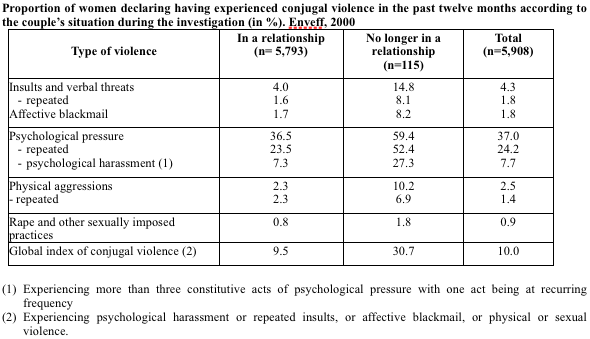Conjugal violence in France
 This article is based on a master thesis carried out by Clara Donadello entitled “Analysis of France’s policy in treating and preventing conjugal violence”.
This article is based on a master thesis carried out by Clara Donadello entitled “Analysis of France’s policy in treating and preventing conjugal violence”. Enveff
The national investigation of violence against women, Enveff (Enquête nationale sur les violences envers les femmes en France) remains the first and only large-scale statistical study on violence against women in France. Before its implementation, the number of two million of battered women floated around, without any reliable verification of its source.Jaspard, Maryse. “L’Enquête nationale sur les violences envers les femmes en France
(Enveff): Historiques et contextes.” Violence envers les femmes: Trois pas en avant
deux pas en arrière. Ed. Natacha Chetcuté and Maryse Jaspard. Paris:
L’Harmattan. 2007. pp. 25-38. The phenomenon was quite unknown as statistics made available by administrative agencies did not take into account gender, and even though victim organizations gauged the problem, no statistical research existed on the scale of the problem in France.Fougeyrollas-Schwebel. “Violence against women in France: The context findings and impact of the Enveff survey.” Paper for the Division for the Advancement of Women, expert group meeting. 11-14 April 2005. Enveff’s purpose was to provide reliable statistic on the various forms of violence against women, the perpetrators, the places in which the violence took place, and the context of the acts of violence.
Method
During the investigation, 6,790 women between the ages of 20 and 59 were questioned over the phone about their experiences with various forms of violence in all spaces and interactions they navigate. Through questions concerning women’s experiences with violent behavior from a partner they have or have not cohabited with during the past twelve months of their lives, Enveff was able to analyze conjugal violence and distinguish violence from conflict.
Results
The publication of the results revealed the scale of the problem: one out of ten women had experienced some form of conjugal violence within a twelve months period. Enveff found that women under the age of 25 declare more violence than older women, probably due to differences of generations in the perception of the accepted level of authority of a man. Surprisingly, the proportion of women in situations of violence increase with the duration of marriage and women in a serious relationships living on their own experience a higher rate of very serious forms of violence then cohabiting couples, with 6% of women living independently being in serious situations of conjugal violence compared to 2.3% of the total number of women. Women older than 35 with an education level higher than graduate studies report a higher rate of very serious situation of violence than women with lower diplomas. The study could not find a clear link between a couple’s profession and conjugal violence, but it revealed a higher rate of serious violence in couples where the woman is unemployed (paid or not) or a student, and a higher rate of very serious levels of violence in couples where the women is unemployed, inactive with past professional experience, or a manual laborer. As a whole, unemployed women experience greater violence than active women, similarly, women with an inactive partner experience greater violence compared to women with an active partner. However, housewives do not declare more violence.
Similar to the results of other studies, Enveff had difficulties linking alcoholism causally to violence. The rate of “very serious” situations of violence increases from 2% to 25% when the woman is alcoholic, and to 30% when the man suffers from alcoholism. Even though 40% of abuse takes place when one of the partners is under the influence of alcohol, 60% of aggressions involve sober partners. Therefore, alcohol is a catalyst of abuse, but is not at the origin of violent behaviors, especially since alcoholism is a symptom of other problems: such as unemployment or other personal difficulties.

Observatoire national de la délinquance
The Observatoire national de la délinquance, the National Delinquency Observatory, created in 2003, reported 47,573 acts of voluntary violence on women over 18 by a partner or ex-partner in 2007, an increase of 31.1% in three years, a statistical increase attributable to better monitoring. This number includes France and its four overseas departments.Ponvoisin, Valerie and Cyril Rizk. “Plus de 47 500 faits de violences volontairs sur femmes majeurs par conjoint ou ex-conjoint on ete enregistres par la police et la gendarmerie en 2007, soit 31% de plus qu’en 2004.” Grand Angle, No. 14 (Juillet 2008) The Observatory interprets the increase as a result of expanded domestic violence laws and sensitization campaigns in the police. Following extensive interviews, the Observatory found that 2.3% of surveyed women between the ages of 18 and 60 claimed having experienced physical violence from a partner or ex-partner and only 21% of them had reported such incidents, meaning that 85,000 women reported an incident in the years 2005 and 2006.
National Study on Violent Deaths in a Couple
The National Study on Violent Deaths in a Couple, undertaken in 2008, found that 184 persons died in the hand of a partner or ex partner: 9 children, 156 women, and 27 men.Ministère de l’Intérieure. “Etude Nationale sur les Morts Violentes au Sein du Couple.” 2008 Of the 27 women who killed, 11 were victims of violence by their partners. Of the 156 male authors of violence, 10 had been previously incarcerated or charged, and 14 followed a psychological treatment. The study allowed France to put into perspective the magnitude of the problem: one woman dies each 2.5 days.
Economic costs
Economically, conjugal violence has been evaluated to cost about 1 billion euros a year, with 77.8% originating from acts of conjugal violence against women.Marissal, Jean-Pierre, et Charly Chevalley. Evaluation des répercussions économiques des violences conjugales en France. Paris: La Documentation Française. 2007. 41.8% of costs stem from direct medical costs (hospitalization, mental health, doctors), 15.9% from direct non-medical costs (tribunals, police, emergency shelter), and 42.4% of costs stem from indirect costs (death of newborn, victim, handicap, loss of revenue).
Development
Showing its willingness to combat violence against women, France designed the 2005-2007 Global Plan to Fight Violence against Women, which presented ten measures for the autonomy of women. The 2005-2007 plan recommended unprecedented measures for the protection of women, such as the extension of the aggravating circumstance to former partners, as well as the implementation of the eviction of the violent partner from the domicile.Ministère du Travail, des Relations sociales, de la Famille, de la Solidarité et de la Ville. Plan global de lutte contre les violences faites aux femmes 2005-2007. 10 mesures pour l’autonomie des femmes. The following plan, for 2008-2010, recommended a global intervention plan for authors of violence to prevent the recurrence of conjugal violence.Ministère du Travail, des Relations sociales, de la Famille, de la Solidarité et de la Ville. Douze objectifs pour combattre les violences faites aux femmes. Deuxième plan global triennal (2008-20010). Objective 5 proposes to evaluate the eviction of the violent spouse from the domicile, to draft a chart of principles of structures for authors of violence, to distribute a document for violent men in police stations, penitentiaries, city halls, and to develop more rehabilitation structures. The evaluation of the global plan 2008-2010 should shed more light on France’s adequacies and inadequacies, as well as the report presented to the Parliamentary Assembly due in 2011.
The National Assembly has been discussing the creation of a National Observatory of Violence Against Women that will be responsible for collecting and analyzing research on violence against women with the collaboration of local, national, and international organizations, as well as evaluate the application of plans to reduce violence against women.Assemblée Nationale. Proposition de Loi renforçant la protection des victime et la prévention et la répression des violences faites aux femmes. N˚2121. 27 Novembre 2009.
Finally, a group of deputies have proposed to create article 222-13-1 on psychological violence, based on a similar article concerning psychological harassment at work, by which a spouse, pacsed partner, domestic partner, actual or past, could receive three years of prison and €75,000 fine in the event of “repeated words or acts for the purpose or causing the degradation of the victim’s life conditions that could affect the victim’s rights or dignity or causing an alteration of physical or mental health.”Assemblée Nationale. N˚2121. However, some researchers show skepticism as to the actual application of such an infraction, mostly due to the difficulties in proving psychological violence.


